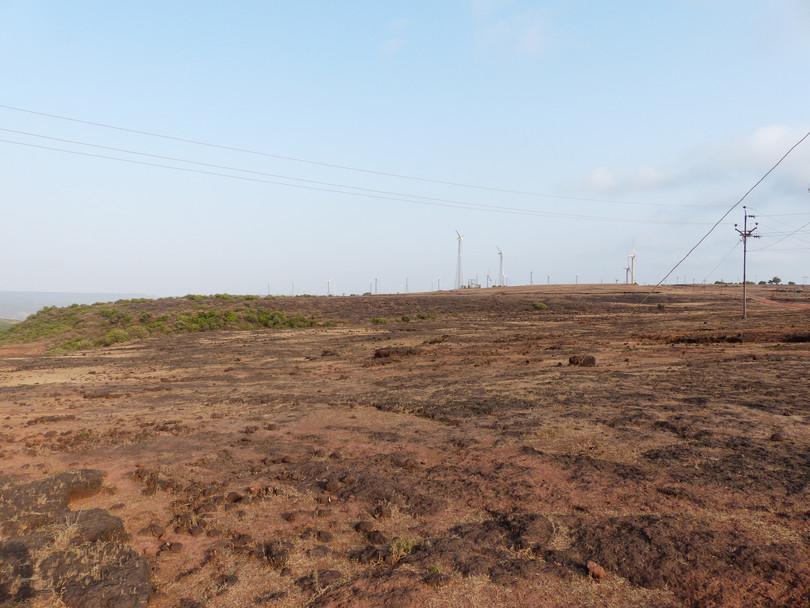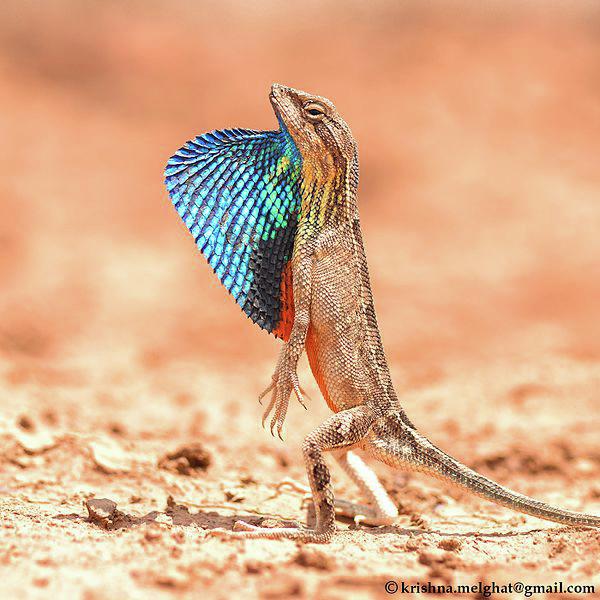
A1 Western Ghats
A1.1 Introduction to the Western Ghats
-
Capacities taught in this chapter
Scientific processHow do windmills affect wildlife?Scientific toolsWhich tools are useful in studying biodiversity in an area?
Which tools are useful in studying the impact of human use of natural areas?Reading and interpretingHow are plant and animal species distributed in a landscape?Bridging science, society and the environmentHow are natural resources and livelihoods interconnected?Quantitative skillsHow do we quantify biodiversity?
As students of biology, we are fundamentally motivated by the beauty and wonder of our natural surroundings. India is home to many varied landscapes, flora and fauna. No matter where you live, in a village, in a town, or in a large metro, you will have observed animals and plants of many shapes and sizes. You may also have wondered how we humans help or harm nature. In this chapter we will use the example of the Western Ghats to understand several biological concepts and the process of science. We will also examine human impacts on the specific landscape of the Western Ghats.
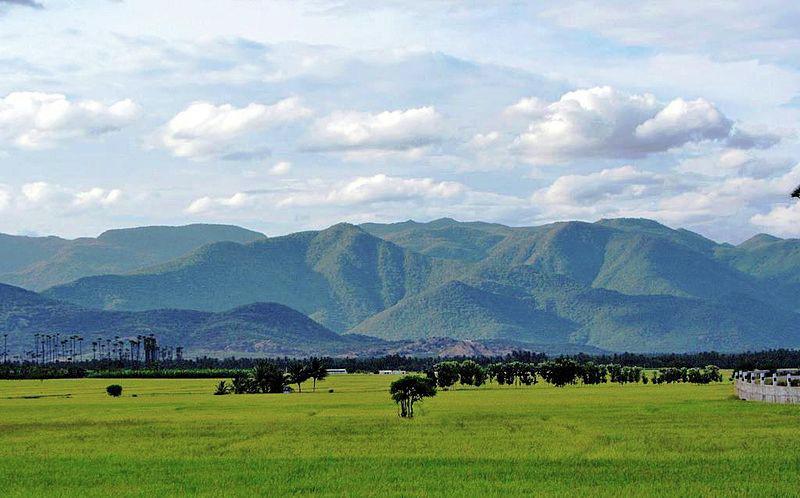
Figure A1.1 View of the Western Ghats from Tamil Nadu.
Magentic Manifestations, Wikimedia commons, CC-BY-SA 3.0.
- biodiversity hotspot
- A biogeographic region which is rich in biodiversity and has many species that are in danger of becoming extinct.
- catchment area
- The area from which rainfall drains into a river.
The Western Ghats (Figure A1.1), are designated as a biodiversity hotspot due to the richness of flora and fauna present there. The Western Ghats are a range of mountains that stretch for 1600 km across several Indian states including Gujarat, Maharashtra, Goa, Karnataka, Kerala, and Tamil Nadu. Although the Western Ghats hotspot region is a thin mountainous strip, its catchment area – an area that uses its services – is much larger (Figure A1.2).

Figure A1.2 The Western Ghats: a biodiversity hotspot.
- escarpment
- A steep slope formed between two relatively flat regions which are at different heights.
The Western Ghats are one of the largest escarpments in the world, formed when India broke off from the Seychelles. A series of violent volcanic events around 65 million years ago that created the Deccan Plateau also contributed to their formation. Erosion of this deposited volcanic material which is largely basaltic rock has given them their present shape.1
The Western Ghats act as a barrier for the south-western monsoon winds resulting in high rainfall in the monsoon season between June and September. The rainfall average is between 300 cm and 400 cm, with some places such as Agumbe (Karnataka) experiencing much greater precipitation (>700 cm). The weather is warm and humid for the greater part of the year.
- endemic
- In animals and plants, endemic means a species that belongs to and is restricted to a particular region. In a disease, endemic means occurring regularly in a certain area or among certain people, animals or plants.
The formation of the Western Ghats through events such as the breaking off of India as an isolated land mass, its docking with Eurasia, its high elevation, and its present favourable weather patterns have contributed to the high rate of speciation of plants and animals. This has led to tremendous biodiversity and a high degree of endemism in the plants and animals of the Western Ghats.
The Western Ghats are a UNESCO World Heritage site and one of ten ‘hottest’ biodiversity hotspots in the world. There are approximately 7000 plant species found in the Western Ghats, with nearly 650 being tree species. Of these tree species, 352 (54%) are endemic to the region. Animal diversity is also high, with 179 species of amphibians (65% endemic), 157 species of reptiles (62% endemic), and 219 species of fish (53% endemic). Similarly, it has 508 recorded bird species, of which 16 are endemic.2 3
The different regions of the Western Ghats also have unique ecosystems, such as the shola grasslands in the southern regions, the high Sahyadri plateaus and the Myristica swamps. They harbour large populations of Asian elephant, tiger and gaur, animals that are known as ‘landscape’ species since they inhabit large, ecologically diverse areas and also have an impact on them in significant ways. The Western Ghats are also the source of the major watersheds of South India, with the Godavari, Krishna, Kaveri, Thambiparani and Tungabhadra rivers all originating in these mountains. The approximately 245 million population of peninsular Indian is dependent on these watersheds for water supply for everday living, agriculture and industry. The Western Ghats thus play a central ecological and economic role in all of the states in which they are found.
We will use research conducted in the Western Ghats to illustrate the different ways that scientific investigations are carried out. Studies conducted in the Western Ghats show how large-scale phenomena have led to the current distribution of animals and plants and how intricately linked these are with human activities. Our current knowledge of the Ghats has been obtained through various studies and approaches, from long-term observations of animal behaviour to investigations at the molecular scale. In exploring these studies, we will investigate predatory bird and lizard interactions, species classification using DNA data, and the influence of mining on riverine systems.
A1.2 Scientific discoveries
Scientific process
The scientific process
Fundamentally, science, including biology, is an endeavour of discovery. Biology is the pursuit of discovering and understanding nature. The joy of discovery is one of the strongest motivations for doing science. Imagine that you have just made an important discovery. For a few moments, days or months, you might be the only person in the history of humankind to know one of nature’s secrets. Isn’t that awe-inspiring?
So, how are discoveries made? Does one need an advanced degree to do science? Does one need to be an expert or a genius? Let’s focus on the first question and we will return to the other two towards the end of this section. In abstract terms, a discovery is made by the steps outlined below. It is important however to note that these are a set of guidelines, rather than a strict set of instructions. In practice, each step may not be followed in the particular sequence given below. This is an attempt to systematise discovery, or what is now called the scientific process.
- parameter
- A property used to characterise something.
- hypothesis
- A testable explanation for an observation or idea, based on available data. The hypothesis can be proved or disproved based on the results of investigation.
| Scientific process | |
|---|---|
| 1. | An observation is made. |
| 2. | The parameters that affect the system are studied to ask a relevant question about the system. |
| 3. | A hypothesis is formulated to describe the reason for the phenomenon. |
| 4. | An experiment or field study is designed and conducted to test the hypothesis. Ethical considerations become important when doing biological experiments and the study designed may need to be examined by an ethics panel. |
| 5. | Measurements and/or observations from the experiment or field study are collected and analysed. |
| 6. | Results are interpreted to reach a conclusion that may prove or disprove the hypothesis. |
| 7. | Results are written up as a scientific paper and submitted for peer review. The authors revise it according to the comments of peer reviewers. |
| 8. | The paper is published in a scientific journal. Increasingly researchers are also using preprint websites like BioRxiv.org for publishing their results and making them accessible to the scientific community before peer reivew. |
| 9. | The findings of the paper are communicated by the authors on various platforms including social media. This is a part of democratising science and scientists need to think of this as part of the process. Sharing findings with the public is assuming importance now as there is greater interest and engagement by citizens with scientific knowledge. |
Table A1.1 The scientific process shown as a series of steps.
Wind turbines in Western Ghats: an illustration of the scientific process
We will go through a general roadmap for scientific discovery in this section, using the example of the impact of wind turbines in the Western Ghats.4 By the end of this section, you should be able to match each step of the wind turbine study to one of the points of the scientific process as outlined in Table A1.1.
The context
- fossil fuel
- Coal, crude oil and natural gas produced through compression of dead organic matter (plants and animals) over millions of years.
In this era of climate change, where carbon emissions due to human activity from fossil fuel usage are ever increasing, we must make large efforts to decarbonize our energy generation. Sustainable power sources such as wind farms are a popular alternative to fossil fuels. Wind turbines ‘harvest’ wind energy to generate electricity.

Figure A1.3 Windmills on the Chalkewadi Plateau, Satara, in the Western Ghats.
Shomen Mukherjee, CC-BY-NC-ND.
Wind farms have been established on the plateaus of the Western Ghats since the early 2000s (Figure A1.3). Wind farms are a green source of power, but they take up large areas of land. Worldwide, nearly 17 million hectares of land are utilised for wind farms.
Thaker, Zambre and Bhosale4 investigated the environmental impact of wind farms on the Chalkewadi Plateau in the Satara district. This research paper illustrates how they followed the scientific process in their research.
Thaker and colleagues observed that wind farms seem to influence migration patterns, as well as populations of birds, bats and local terrestrial animals. They investigated whether wind turbines influenced predatory bird populations.
- control
- An experimental setup that lacks the factor being tested while all other variables are held constant.
- space for time substitution
- Substitution of time with space in experiments in which the effect of the passage of time on a system cannot be observed. Assumes that variables that change across time will also change across space.
Ideally, they should have measured the predatory bird population before and after wind turbines were installed. Since it is no longer possible to measure the population before the turbines were installed, Thaker et al. made a ‘space for time’ substitution. They identified an identical area of land (without wind turbines) in which all known parameters such as temperature, humidity, soil and vegetative composition were the same as on the wind farm (Figure A1.4a). Observations made from this land served as the control measurements.
The next problem was how to estimate the population size. Predatory birds fly over great distances, so counting individual sightings does not give an accurate estimate of population. But the birds are active during the day when observers can see and count their predation attempts. Measuring numbers of predation attempts is an indirect way of estimating the size of a population of predatory birds.
Thaker and her colleagues counted the number of predation attempts in the area without wind turbines and the area with wind turbines in the same season. It was important to do this in the same season because of variability in bird populations in different months in the same year. They found that the population of predatory birds in the Chalkewadi Plateau was three times lower in areas with wind turbines than without (Figure A1.4b).
Since the major difference between the control and experimental sites was the presence of large wind turbines, this population size difference could therefore be attributed to the presence of wind turbines.
Impact on prey species
The researchers extended their study by asking what impact the reduction of predatory birds has on the population of prey species. Predatory birds such as the white-eyed buzzard and the black-shouldered kite prey on small terrestrial vertebrates such as lizards.
- predator release
- An increase in the population when a species is freed from predation.
The fan-throated lizard (Figure A1.4b) is susceptible to attacks by these predatory birds. A reduction in predator population may act as a predator release, in effect allowing the lizards to ‘relax’ as their chances of being predated on are reduced. The predator release may then also lead to other behavioural, morphological or physiological changes in lizards.
Box and whisker plots of the kind shown in Figure A1.4c and d are a convenient way of showing distributions. The box represents the middle 50% of the data set, the line in the middle represents the median (the middlemost value), and the whiskers or the lines depict the range (or most of it, if there are outliers). For more information, you may consult the resource What is a box and whisker plot?.
The researchers counted the numbers of lizards in areas with and without wind turbines. They collected blood samples from lizards in both areas and measured the levels of the stress-induced hormone, corticosterone. They also measured how closely they could approach the lizards before they ran into hiding.
Their results showed significant differences in lizard populations. Firstly, the lizard population was three times higher in the presence of wind turbines than in an area with no turbines. Lizards in areas without wind turbines had much higher levels of corticosterone than those living on wind farms. Finally, the fan-throated lizards in areas with wind turbines allowed predators to approach much closer (~3 m) than in areas without wind turbines.
- trophic level
- The position an organism occupies in a food chain.
Together, these three lines of evidence suggest that the reduction in predatory birds due to wind farms allows lizard populations to increase. Thus, wind farms act as an apex predator, leading to a cascading predator release effect on a lower trophic level. As a consequence, lizards produce less stress hormone, and appear to initiate a reaction to the presence of predators only at short distances.
Exercise A1.1 Did they follow the scientific process?
Scientific processReading and interpretingIdentify the steps of the scientific process followed by Thaker et al. when they studied the impact of wind farms on prey species. Use the outline in Table A1.1 when you fill out this table.
Step Observation Question Hypothesis Experiment Results Conclusions Table A1.2 Checklist of the scientific process followed by Thaker et al.
What steps did Thaker et al. take after they completed data collection? See if you can follow their scientific process until their research was published in their article ‘Wind Farms Have Cascading Impacts on Ecosystems across Trophic Levels’.
Note that this study does not suggest we stop using wind farms altogether, rather that we take into consideration all the effects of wind farms while designing them.
The many paths of discovery
In the previous section, the process of scientific discovery was illustrated using the example of the ecological consequences of wind farms in the Western Ghats. Now that you are familiar with one example of the discovery process, we can look at a few more and explore other ways for making discoveries.
Let us consider four examples of scientific investigations that were conducted in the Western Ghats.
- The first investigation illustrates how scientists assess the threat status of a bird, in this case the Nilgiri pipit (Anthus nilghiriensis).5
- The second investigation illustrates how scientists identify and describe new species, in this case two lizard species in the Western Ghats.6
- The third investigation illustrates how scientists document indigenous practices. The example we have chosen investigates awareness and practices of members of Kani forest tribe members towards cutaneous leishmaniasis,7 a tropical disease occurring in parts of the Western Ghats.
- The fourth investigation is an impact assessment, using the example of iron ore mining in the Kudremukh region on the amount of sediments in the Bhadra river.8
Together, these four studies will give you an idea of the different types of investigations that can be carried out.
Assessing the threat status of a species
- endangered
- Species whose population size indicates a chance of going extinct in the wild. See also: vulnerable.
Robin, Vishnudas and Ramakrishnan5 were interested in the threat status of the Nilgiri pipit (Figure A1.5a). They studied this by surveying the habitat in which the pipit occurs. Is it under threat of becoming extinct? We will explore the concept of an endangered species later in this chapter. For the moment, imagine you are the scientist performing this investigation. What observations can you make that will allow you to evaluate the threat status? Does this question require a controlled experiment to answer? What are the possible outcomes of your investigations?
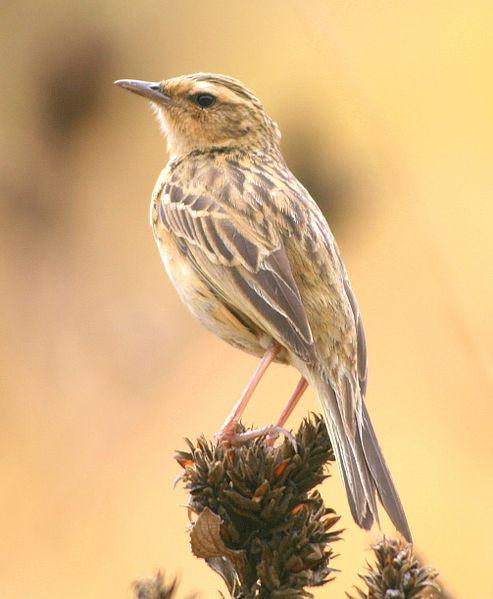
Figure A1.5a Nilgiri pipit.
Nishad H. Kaippally, Wikimedia commons, CC-BY-SA 3.0.

Figure A1.5b Museum specimens of pipits from Bombay Natural History Society.
Robin Vijayan.
The researchers incorporated two unusual sources of data: they looked at historical records of where the bird used to be found, and they examined specimens stored in various museums around the world. Museum records proved very useful as they provided information on where the specimen was collected, allowing the researcher to determine the historical range of the bird. They also used data collected by amateur bird watchers, which are stored in public databases (like ebird.org). Overall, their conclusions were that the habitat of the bird is restricted to around 450 km2 and not nearly 12 000 km2, as was previously thought. Given the restricted habitat (which is also susceptible to destruction by human activity) and the declining population, they proposed that the species be considered endangered.
Extra reading Citizen science: involving the public in the scientific process
Citizen science involves laypersons in science projects and initiatives. Citizen scientists can collect data through observations or surveys, classify or confirm collected data, and solve scientific problems.
Many citizen science projects are related to issues such as environmental pollution that directly affect citizens. Involving citizens helps to popularise science, raising awareness of scientific methods and how important scientific investigations are. Involving the public increases the amount of data that can be collected.
Read more about citizen science initiatives have been undertaken in India:
Identifying and describing new species
In the second study, Pal et al.6 reported the discovery of two new lizard species in the Western Ghats (Figure A1.6). We will examine the concept of a species more closely later in this chapter. Imagine that you spot an animal that you have never seen before. How will you identify this animal? How can you find out if you have discovered a new species? Your first attempt might be to search the Internet using physical characteristics, such as ‘red insect with black spots’ or ‘yellow feathered bird’. You might come across an image that is similar to the animal you saw.
You may have identified some behavioural characteristics of the animal. Where does it live? Is it active during the day or night? What sounds does it make? Perhaps you saw several individuals, not just one. Do all individuals look similar?
Pal et al. used physical and behavioural observations. Physical observations included photographing individual lizards in controlled conditions for determining colouration and measuring morphological characteristics of the lizards. The authors were painstaking in their approach and measured 33 different parameters related to body size (such as snout to vent length, tail length, and head width). Behavioural observations included the time in which a particular lizard species was active (day/night) and also the kind of elevation they were found in, classified as low, medium, high and montane elevations. They also used sensitive DNA-based techniques to identify and classify lizard species in the Western Ghats. These DNA-based techniques are explored in the chapter on rice.
Television crime shows sometimes use ‘DNA fingerprinting’ to identify a suspect. This works because every individual has unique DNA sequences that is their ‘DNA fingerprint’. Looking for differences in DNA can distinguish between species. Based on the combination of physical, behavioural and DNA characteristics, Pal et al. identified two new species of lizard. These lizards had been seen before. The careful analysis performed in this study revealed sufficient differences to require the reclassification of lizards that were previously assumed to be the same species.

Figure A1.6a Monilesaurus montanus, a new lizard species found in the Western Ghats.
India Biodiversity Portal, CC-BY 4.0.
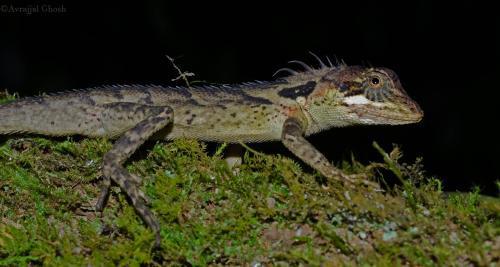
Figure A1.6b Monilesaurus acanthocephalus, a new lizard species found in the Western Ghats.
India Biodiversity Portal, CC-BY 4.0.
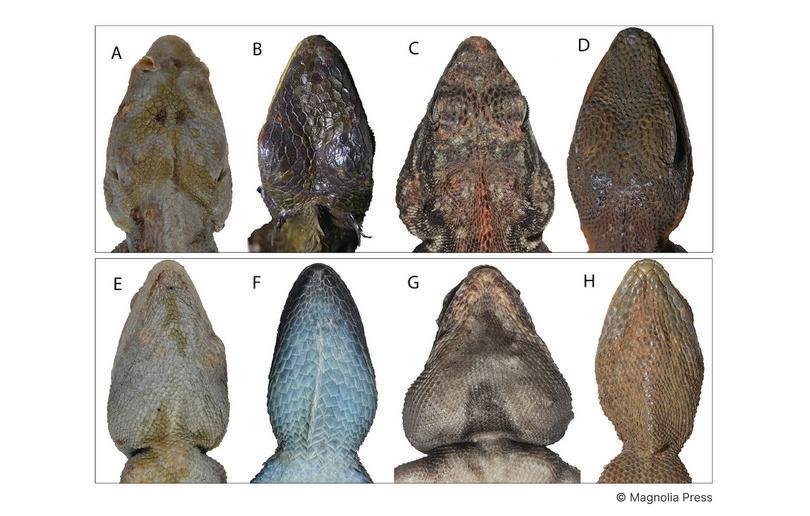
Figure A1.6c Dorsal and ventral close-ups of head characteristics of four sister clades A., E. Monilesaurus; B., F. Calotes; C., G. Psammophilus; and D., H. Microauris.
Pal, S, ‘A Systematic Revision of Calotes Cuvier, 1817 (Squamata: Agamidae)from the Western Ghats Adds Two Genera and Reveals Two New Species’, Zootaxa 4482, no. 3 (2018). Reproduced with permission from the copyright holder.
Documenting indigenous practices
The third study is an example of a questionnaire-based investigation. Studying human subjects has the advantage that it is possible to communicate using language, an option that is largely absent in other organisms. Nandha, Srinivasan and Jambulingam7 were interested in exploring socio-demographic and environmental risk factors for cutaneous leishmaniasis (CL) in a particular region. They also wanted to determine common perceptions and practices amongst the indigenous Kani people, in whom CL was endemic. Cutaneous leishmaniasis is similar to malaria in that the pathogen is a protist and it infects humans via an insect vector (sandflies).
In Kani tribal settlements, the researchers carried out a survey among different households. They conducted an interview with an adult member of the household (the head of the household was preferred). They tried to evaluate awareness of the disease and the role of insects in spreading the disease, as well as the typical treatment that was sought.
The authors observed that cutaneous leishmaniasis did not have a name in the local language and was referred to generically as ‘heat boil’. Moreover, only around 40% of the interviewees were able to identify the disease when shown photographs of skin lesions. There was no knowledge that sandflies played a role in disease transmission. Instead, there were misconceptions such as the disease being transmitted by contact, spread by mosquitoes, or being an allergic reaction to some plants. Individuals who showed symptoms of the disease tended to self-medicate using natural herbs or seek the help of traditional healers.
- indigenous knowledge
- Knowledge derived and possessed by an indigenous or local community.
Overall, the authors suggested that there was a need for ‘adequately educating the inhabitants with a long-term programme on personal protection and prevention’.7 The authors were not suggesting that tribal populations have poor practices. In fact, the study specifically mentions that traditional healers can play an important role in disease prevention if properly trained. Elsewhere, we will see examples of how indigenous knowledge can contribute to science.

Figure A1.7 Patient with cutaneous leishmaniasis.
Abanima, Wikimedia commons, CC-BY-SA 3.0.
Impact assessment
The fourth study uses long-term data to evaluate how iron ore mining in the Western Ghats impacts sediment levels in the adjoining rivers (Figure A1.8).8 We will examine the impact of mining in the Kudremukh National Park in greater detail in section A1.4. For now, let’s focus on the amount of sediments released into the river.
There are natural sources of sediment, so how can we be sure that mining is the predominant source? One line of evidence that Krishnaswamy et al. used was photographs of the river upstream and downstream of the mining site.8 In the upstream photos, the water is relatively clean, whereas the downstream photos show that the river is murky due to iron ore sediments and soil erosion from mining activities.
While photographs point out the impact of mining, they can be misleading. The photos could have been taken on a day of particularly high sediment release, especially during the monsoon months. This is where long-term, quantitative measurement of sediment levels becomes important. The authors used sediment level measurements conducted in the 1980s (prior to the start of mining) as well as newer data collected in the 2000s (when mining was an ongoing activity) to show that mining was the major source of the sediments. They were also able to establish a relationship between heavy rainfall and sediment levels, which again implicated mining as the source of sediments, since open mines are more susceptible to erosion.
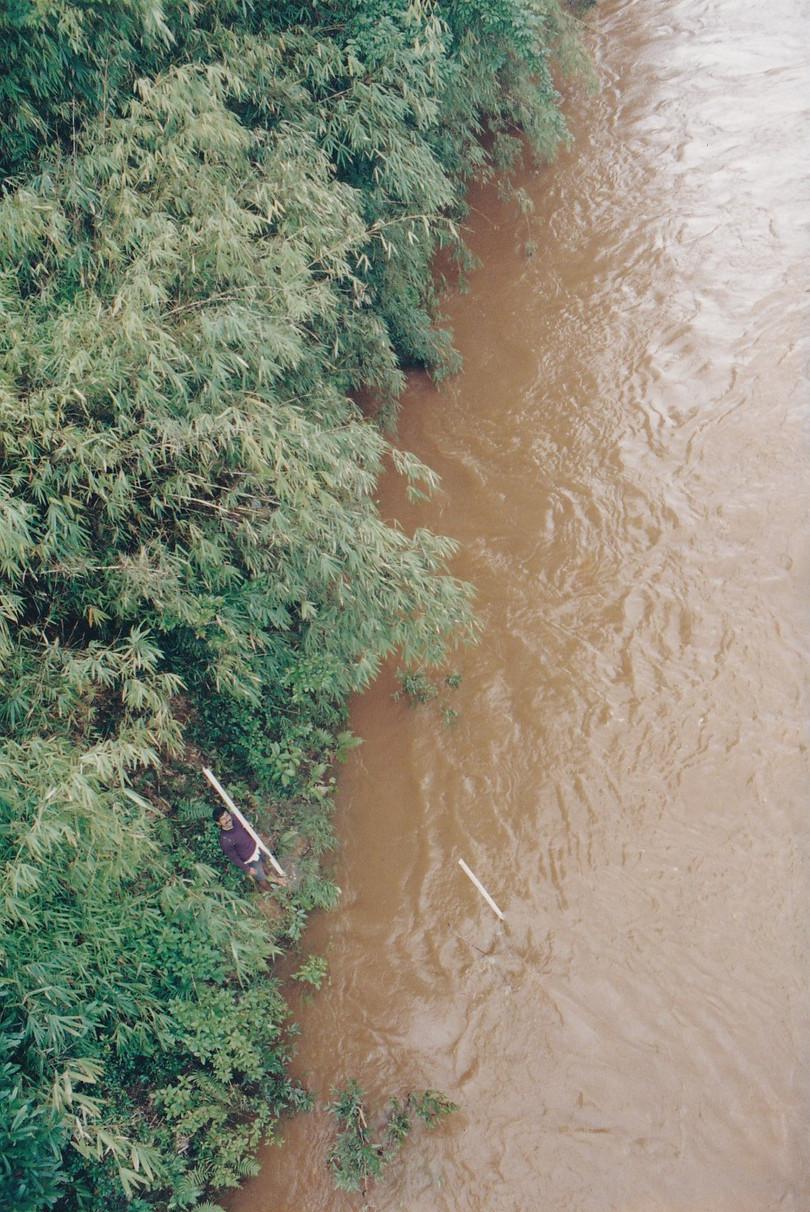
Figure A1.8 Impact of iron ore mining in the Kudremukh region, shown by the orange colour of the river due to the sedimentation of iron ore.
Niren Jain.
Summary: the nature of discovery
Let us now synthesise some of the themes that have emerged in the previous two sections. Think about the examples that were discussed. Did they all try to address specific questions? Was a hypothesis being tested in all of them? What role did data/measurements play in arriving at the conclusion? What was the nature of the data collected? What were the outcomes? Did you find that the studies were quite different in scope and methodology? As you read iThink Biology, you should keep these questions in mind.
Now that you are more familiar with the scientific process, we would like to point out some of its important aspects.
- The scientific process takes time: The process of discovery requires patience and perseverance. It often takes years for a study to be completed. Think about how much patience one needs to spot a rare species. Discoveries are not made in an instant. An initial finding (the ‘moment’ of discovery) is typically followed up by additional work. If possible, the finding is verified by repeating the experiment or by collecting more data. Alternatively, additional lines of evidence are acquired to support the original finding. Think about the wind farm study. The impact of reduced predation was not just assessed using population size of the prey. It was corroborated by examining stress hormone levels as well as changes in behaviour.
- Making discoveries is a creative process: There are no shortcuts and there is no simple method that always works. And you can never be sure what might inspire your next idea. You may also have to be imaginative about using different sources of data. For example, ecologists increasingly find that museum specimens that were collected 100 to 200 years ago are important as they can provide clues about climate and ecology from that period. This is an example of being creative in the use of existing data.
- The nature of discovery is uncertain and many results can be ‘small’: Name a scientific discovery that you know about. You probably chose a ‘big’ discovery, such as the structure of DNA or the discovery of the cellular basis of life. However, in a majority of cases the impact of what has been discovered is uncertain. It is only later as other researchers build on previous discoveries that it is possible to determine the significance of a particular discovery. Therefore, it is best if a scientist is interested in the questions being asked and uses that interest to drive their work, rather than thinking about the significance or impact the results might have. It is important to ask questions that are central to a particular discipline and which could also have deep social impact, but it may not always be possible.
- Do not assume the process of discovery is mistake free: The process of discovery is an enquiry into the unknown. Due to the nature of the process, mistakes are inevitable. There are many famous mistakes in the history of science. If you wish to be a scientist, you must be willing to learn from mistakes.
- The body of scientific knowledge is not static: Our current understanding of a system may change when new evidence is collected or when new tools and technologies become available. We might also find new ways of thinking about our system that are more illuminating. The identification of new species of lizards is an example of how new tools alter the prevailing understanding.
Finally, do realise that there are still discoveries to be made. Isn’t it remarkable that new species are still being found? Furthermore, as the citizen science initiatives demonstrate, you do not need an advanced degree or special expertise to contribute to science.
Exercise A1.2 Designing experiments
Scientific processReading and interpretingResonance is a journal about science education published by the Indian Academy of Sciences. Raghavendra Gadagkar, an eminent scientist, has written a series of articles on designing experiments in animal behaviour in this journal. Visit the journal web site and use the search feature to identify these articles. Read a few of these articles.
- For each study described in the articles, identify the question being addressed, the hypothesis being investigated, and the conclusions drawn from the results.
- Reflect upon the process of science described in each article. What are the challenges of making discoveries?
A1.3 Plant and animal distribution across the Western Ghats
Reading and interpreting
Understanding patterns in nature
While traveling across the countryside, you might notice a landscape full of trees, surrounded by grassy patches. As a biologist this may raise questions in your mind. Are different plants and animals uniformly distributed? Do they occur in clusters or patches? The geographical pattern of species distribution is an important question in biology.
- Tropic of Cancer
- The line of latitude approximately 23.5°N of the equator. The sun is directly over the Tropic of Cancer during the northern hemisphere summer solstice.
India is a tropical country that is host to a large diversity of species. The Tropic of Cancer passes through India. Does the relative position of India on the globe contribute to species diversity? Many scientists have tried to explain this pattern.9 10 11 12
- species richness
- The number of different species that coexist in a region or community.
Eduardo H. Rapoport,13 14 an Argentinian ecologist, proposed the idea that species richness increased with decreasing latitude. He was the first scientist to ask the question: why do the tropics have so many species while polar regions don’t?
Rapoport tried to explain this observation in terms of tolerance. You can think of tolerance as a set of mechanisms that allow the survival and productivity of an organism under a stressful condition. Rapoport said that if a species is found in any particular environment, such as the mountains of the Western Ghats, it will be able to tolerate all the stressors (abiotic and biotic) that are prevalent in the Western Ghats mountains. A mosaic of such abiotic and biotic stresses gives rise to the presence or absence of different kinds of species in a landscape. In this way, tolerance gives rise to the species distribution patterns in that landscape, for example, the view outside your window.
What is a species?
When we group or classify different kinds of living organisms, we tend to put them into boxes based on characteristics that they share. The smallest box recognised in biology is known as a species.
- biological species concept (BSC)
- A concept that defines a species as a group of organisms that can mate with each other and produce fertile offspring.
- phylogenetic species concept (PSC)
- Concept of a species as the smallest group of organisms that have descended from a common ancestor.
- phylogeny/phylogenetic tree
- A branching diagram representing a hypothesis about the evolutionary relationships among a group of organisms.
The Biological Species Concept states that a species consists of similar organisms that can interbreed successfully.15 16 Hybrid offspring are generally infertile or sterile.
The Phylogenetic Species Concept defines a species as the smallest set of organisms in a phylogenetic tree that share a common ancestor that can be distinguished from other such sets. See the chapter on rice for more information.
Patterns of species distribution
- dominant species
- A species that occurs more frequently in an ecosystem than other species.
- rare species
- A species that occurs at very low frequencies.
Different species have a range of tolerance for abiotic and biotic factors. Based on these, certain species can occur within an area with other species to form an ecological community. In a specific community (such as the Nilgiris district in the Western Ghats, for example), all species are not uniformly distributed. Some species are more abundant (dominant species), pushing most others to occur rarely (rare species). To understand some of these terms, we will use the example of a scientific study done by Parthasarathy in Kalakad-Mundanthurai Tiger Reserve in the southern part of the Western Ghats.
Parthasarathy conducted the study in an evergreen forest community in the Western Ghats.17 The prime objective of this study was to understand the patterns of tree diversity and abundance in three different forest types. He called them undisturbed, selectively felled (where some particular species of trees had been cut for various purposes, such as timber), and moderately disturbed forests (sites that had seen heavy disturbance previously, but had been regenerating for the previous 35 years). To study the forest community composition, he delineated some forest plots within these forest types and recorded all the tree species within each of these plots. He then generated three lists of tree species from these plots.
Parthasarathy compared the three lists and saw a very interesting pattern. He found that some trees that were dominant (greater in number) in the undisturbed forests, had very few individuals in the heavily disturbed areas.
- endemic
- In animals and plants, endemic means a species that belongs to and is restricted to a particular region. In a disease, endemic means occurring regularly in a certain area or among certain people, animals or plants.
Consider the example of two tree species. Cullenia exarillata (Figure A1.9a) is an endemic species, and an abundant tree species of the southern Western Ghats. An endemic species is one that is not found anywhere else on Earth. However, within its range of distribution, C. exarillata is common, making it an abundant species in the undisturbed forests of the southern Western Ghats (Figure A1.10). On the other hand, Dimocarpus longan (Figure A1.9b), a tree species widely distributed across many southern Asian countries, was found to be dominant in moderately disturbed forests, while in undisturbed forests their numbers were smaller (see the orange bars in Figure A1.10).
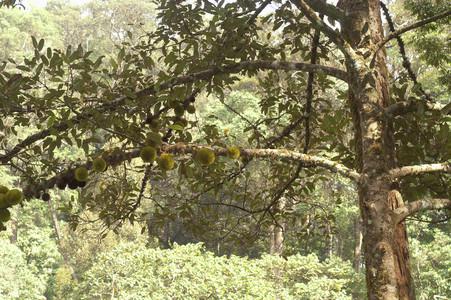
Figure A1.9a Cullenia exarillata, an endemic tree species in the southern Western Ghats.
Pierre Grard, India Biodiversity Portal, CC-BY 4.0.

Figure A1.9b Dimocarpus longan, a species distributed across southern Asian countries.
Useful Tropical Plants Database, CC-BY-SA 3.0.

Figure A1.10 Difference in tree abundance in undisturbed, selectively felled and moderately disturbed forests.
Data from Parthasarathy, N, ‘Changes in Forest Composition and Structure in Three Sites of Tropical Evergreen Forest around Sengaltheri, Western Ghats’, Current Science 80, no. 3 (2001): 389–393.
- keystone species
- A species of plant or animal that plays a crucial role in ecosystem function. Its removal could have a cascading impact on the whole ecosystem.
- arboreal mammals
- Mammals that spend most of their time in trees.
In addition to being an endemic species of the southern Western Ghats, C. exarillata is also considered a keystone species by some scientists.18 It is the primary food source of seven arboreal mammals such as monkeys, langurs, squirrels and bats. Bats (and other species) pollinate the flowers of C. exarillata, creating a unique bond between these species. C. exarillata is therefore a pivotal species in this ecosystem. Any disruption of the unique network of interactions between C. exarillata and the animal species would severely impact the functioning of the whole ecosystem.
- vulnerable
- A population of a species that is at high risk of human-induced extinction. See also: endangered.
- endangered
- Species whose population size indicates a chance of going extinct in the wild. See also: vulnerable.
The story becomes more interesting when we examine some of these delicate interactions more closely. Two endemic animal species that depend on C. exarillata for food are the vulnerable lion-tailed macaque (Figure A1.11a) and the endangered Nilgiri langur (Figure A1.11b), both on the IUCN’s Red List.
- habitat
- A place where a species lives.
A species can become endangered or vulnerable for various reasons, one of the most important being habitat destruction. Habitat destruction can be caused by natural disturbances (such as flood or fire) or by human-induced alterations of the environment (such as land-use changes owing to development). Natural and human-induced disturbances lead to changes in the habitat in which species occur. Destruction of the habitat of a species may lead to its decline, possibly even its extinction. If C. exarillata becomes extinct, the lion-tailed macaque and the endangered Nilgiri langur lose an important food source and thus become more vulnerable.
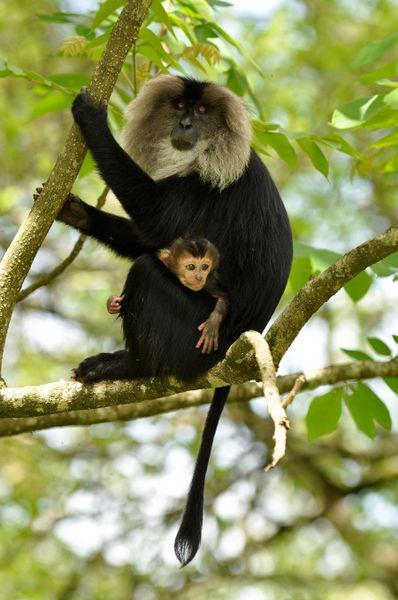
Figure A1.11a Lion-tailed macaque (Macaca silenus), a species endemic to the Western Ghats. Status: Endangered.
TR Shankar Raman, Wikimedia commons, CC-BY 3.0.
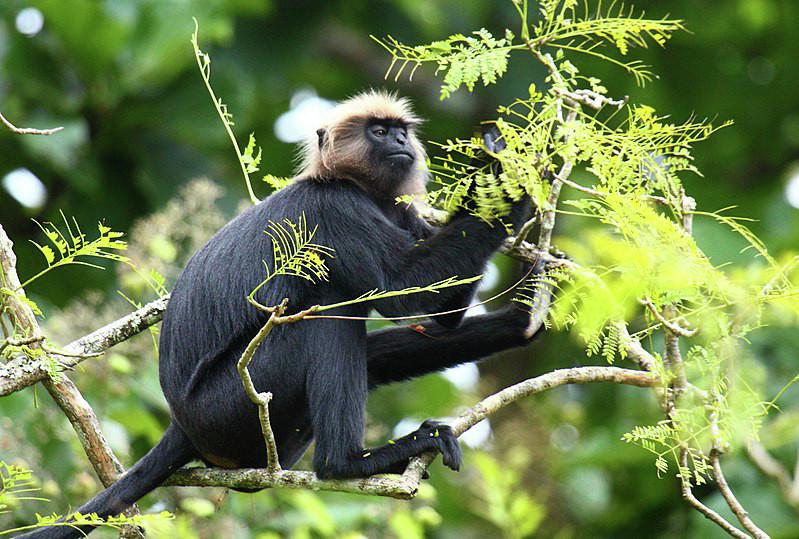
Figure A1.11b Nilgiri langur (Semnopithecus johnii), a species endemic to the southern Western Ghats. Status: Vulnerable.
Joseph Lazer, Wikimedia commons, CC-BY-SA 2.5 IN.
What is biodiversity?
Biodiversity is the variety or variation of living form and function within an area. It includes:
- all the genetic-level variation, or genetic diversity (individual or organism level diversity)
- all the living flora and fauna, or species diversity (population-level diversity)
- the variety of functions that species perform, or functional diversity (community-level diversity)
- the variety of ecosystems these communities form, or ecosystem diversity.
Since species are distributed according to their tolerance, biodiversity is very unevenly distributed across the globe. For example, most temperate regions of the globe have low species richness and abundance (few species that are sparsely distributed), whereas most tropical zones have high species richness and abundance. Some tropical regions are biodiversity hotspots.19
Exercise A1.3 Estimating biodiversity
Quantitative skillsScientific toolsScientific process
- sampling
- An estimation method that involves the collection of data of a subset of individuals from a larger population.
It is usually physically impossible to count the numbers of plant or animal species in a large area. Scientists estimate biodiversity from representative subplots, which are small portions of the area. This is called sampling. We need the following measurements to obtain a quantitative estimate of biodiversity for a given area:
- species abundance
- The number of individuals of a single species present in a region or community.
- evenness
- A measure of how close the species abundance values are for all the different species in an area. Also known as: relative abundance.
- Shannon’s diversity index
- An index of species diversity in a community calculated by considering evenness and species richness. See also: evenness and species richness.
- The total number of species present in an area is called species richness.
- The number of individuals of each species is called species abundance
- Species abundance and species richness can give us an estimate for evenness, a measure of the relative abundance of species in a given environment.
- Biological diversity is an integration of richness and evenness, and can be estimated using Shannon’s diversity index, given by: \(H = - \Sigma\lbrack(p_{i}) \times \ln{(p_{i})}\rbrack\). (If you need help with logarithms, refer to the primer on numbers and scales.)
- pi = proportion of total sample represented by species i (divide number of individuals of species i by total number of samples)
- S = number of species or species richness
- Hmax = ln (S) = maximum diversity possible
- E = evenness = H/Hmax (Shannon’s diversity index)
In the literature, species diversity and species richness are used interchangeably, which can sometimes become confusing.
Now, let us try an activity to understand biodiversity estimation. What do you think is the diversity of items found in all of the bags in your classroom or study circle? Divide yourselves into groups or ‘subplots’ and follow these steps:
Step 1: Unload your bag on the table in front of you (if you are not carrying a bag, unload everything that you are carrying with you in your hand or pockets). Collect the items into groups that share certain characteristics, for example, pens, notebooks, and so on.
Step 2: Record the number of items in each group (for example 5 pens and 3 notebooks).
Step 3: Think of each group of items as a species (that is, pens are species 1, notebooks are species 2).
Step 4: Open a spreadsheet and tabulate your data with the following headings: Species, Number of items (one column for each group).
Step 5: Use the descriptions and Shannon’s formula to calculate species richness, abundance and evenness of the contents of your subplot.
Now that you have these numbers, what do they mean? Can you say that diversity is high? Which subplot in the classroom has the highest diversity of items? Try to calculate the Shannon’s diversity index for the entire classroom to find out which subplot best represents the diversity found in the classroom as a whole.
Summary
In this section we looked at how to define a species and examined some factors that may determine the geographical distribution patterns of species. We then discussed biodiversity and how to measure it using species richness and abundance.
A1.4 Commons: many takers of the Kudremukh National Park
Bridging science, society and the environment
In the previous section you learned about the link between C. exarillata trees and several mammals. Many such links exist across an entire ecosystem. All species, from microbes to mammals (humans included) are intricately intertwined in this web of life. But certain activities of humans can disturb this balance, leading to long-term consequences.
- commons
- Natural or cultural resources that are accessible to all members of a society OR natural resources that groups of people manage for individual and collective benefit.
Who owns natural resources like air, water and land? Are they common property that can be used by all? What can one do when some people overexploit the commons, causing harm to others? What are the social, ethical and legal implications when commons are exploited? We discuss these issues by taking iron ore extraction in Kudremukh in the central region of the Western Ghats as an example.

Figure A1.12 Rolling hills of Kudremukh showing typical shola grassland architecture.
Vikas Rumale, Wikimedia commons, CC-BY-SA-4.0.
- livelihood
- Means of securing necessities for life such as food, water, a place to live, clothing.
The rolling hills of Kudremukh (which means ‘horse face’ in Kannada) with dense forests are one of the most picturesque parts of the Western Ghats (Figure A1.12). This fertile land, the streams, and rivers that flow through it can be considered part of the commons, since many people depend on them for their livelihoods. Due to severe habitat loss, several mammals such as the lion-tailed macaque and the endemic Kudremukh cricket frog (Zakerana kudremukhensis) have become endangered.
In 1987, Kudremukh was declared a National Park to safeguard the wildlife. A national park is an ecosystem that is not exploited or occupied by humans, but visitors are allowed to enter the park for educational, cultural, inspirational or recreational purposes. Kudremukh covers 61 000 hectares of land, spread over three districts in Karnataka, with over 2000 families inhabiting the park. People living inside or near Kudremukh, whose livelihoods depended on the land, were upset about the establishment of the National Park and staged about its formation.
The Kudremukh Iron Ore Company Limited (KIOCL), a government-owned company, was operating in Kudremukh even before it was declared a National Park. Since the company had a 30-year lease, KIOCL continued to mine inside the national park till 1999, and to be active in the area from 2002 to 2006.
- open cast mining (open-pit mining)
- Technique used to obtain minerals and ores that are relatively close to the Earth’s surface through an open pit. Also known as: open-pit mining.
While extracting and exporting minerals may have had huge economic benefits, the damage done to the ecosystem is immense and long lasting. Open cast mining in Kudremukh created several environmental problems:
- The steep hill slopes get around 600 cm of rain every year during the monsoon. Due to mining on these hills, tonnes of topsoil was washed down to the river Bhadra situated downstream of these hills.
- Iron silt was deposited on farmlands during the 2002–2003 monsoons. More than 50% of the sediment load in the Bhadra river and the reservoir came from mining-affected areas that occupied <1% of the catchment area.8
- Fish and amphibian populations in the region have been severely affected.20
- The Lakya dam built inside the National Park to collect all the silt from the mining now holds 150 million tonnes of iron ore waste. If the dam cracks due to an earthquake, a heavy rainfall, or problems with structural integrity, all of that waste would be released into the water.
Ecological costs and livelihood gains from non-timber forest products (NTFPs)
Humans are intimately connected with forests. Even if you live in a city, think of all the products that you use and where they come from: wood for furniture, spices used in cooking, honey, wax, mushrooms, ayurvedic products, medicines, natural pigments used to dye cloth, crafts, the list is endless! What happens if these products are overharvested as demand increases? Will we run out of these resources eventually?
Forest products other than timber are broadly classified as non-timber forest products (NTFP). They range from fruits, seeds, flowers, leaves, bark, latex, resins, wax, meat, animals for pet trade, and even microbes and insects.
Many communities that live near the forests benefit by harvesting NTFPs. In fact, NTFPs generate a large proportion of rural and forest economies. In India over 50 million people are thought to depend directly on NTFPs for their livelihood.21 Unfortunately, present-day demands have led to over-harvesting of NTFPs, creating an imbalance. How can NTFPs be harvested in an ecologically sustainable way to minimise ecological costs and maximise livelihood gains?
The ecological impacts of overharvesting NTFPs are manifold, and often difficult to quantify. Bamboo, for example, was over-harvested in many parts of south India because it was in great demand for the paper and pulp industries. This has severely decreased the populations of bamboo species, even impacting their abundance and diversity.22 In addition, traditional knowledge associated with working with bamboo (such as flute carving and furniture making) is being lost.
Sustainable practices would enable us to harvest a product continuously. However, plant growth and regeneration depend on several factors. Human-caused factors include grazing, fire, hunting, and timber collection. Ecological stressors include damage by herbivory (animals eating plants), the presence of invasive species, pathogens, and how disturbed the ecosystem is in general.23
Over 3000 plant species in India are harvested for NTFP, and in some areas, more than 40% of the household income is estimated to derive from such products. The Kattunayakans, a tribe who live in the Nilgiris Biosphere Reserve in Tamil Nadu and Karnataka, depend on harvesting honey (Figure A1.13). They have a deep understanding of the biology of several different species of bees and have been harvesting honey sustainably for several generations.
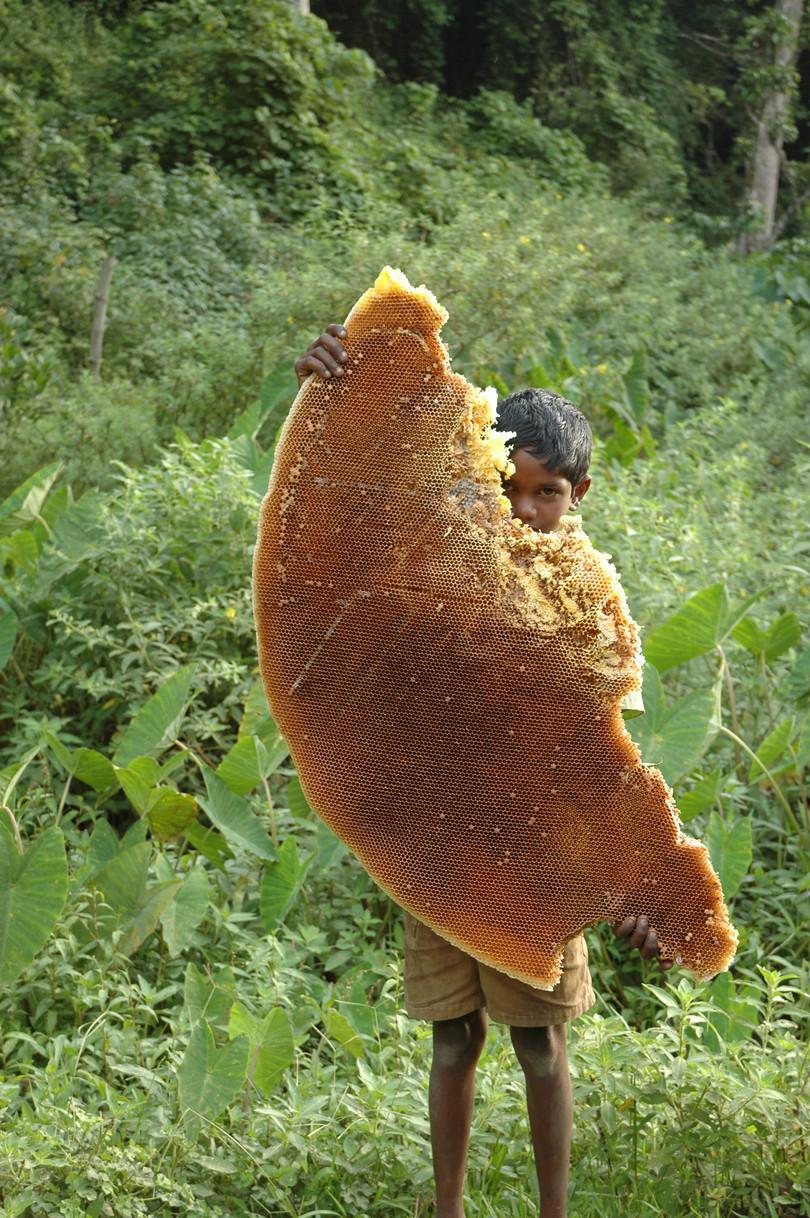
Figure A1.13 Kattunayakan boy harvesting honey.
Tarsh Thekaekara, CC-BY-NC-ND.
In the Biligiri Rangana Hills, Karnataka, the Soligas tribe derive about 60% of their income through NTFP. These products are largely forest fruits, bamboo, honey, lichen, broomstick grass, and roots from certain plants.
An extensive socio-economic survey in the Biligiri Rangana Hills found that it’s often the poorer households that depend more on income from NTFP than the wealthier households.24 They also found that the traditional ecological knowledge (such as when and how to harvest a plant, and what diseases and parasites affect these plants) was greatest in areas where the people depend extensively on NTFP.
In other words, poorer people, with greater dependency on the forest, know how to sustainably harvest the products without upsetting the ecology of the very species they depend on. This was not the case in communities that were less dependent on NTFP. Markets and growing demand for NTFPs can cause over-exploitation of the forest, leading to several ecological problems, ultimately having an impact on the livelihoods of people who are dependent on it.
Summary: making connections
This section has shown us how important it is to connect knowledge across disciplines, for example, identifying sustainable harvesting practices of NTFPs requires us to have a deep understanding of the sources’ growth and reproductive cycles. This understanding must be gained through a discovery process that may require varied methodologies: observations, surveys (both biological and socio-economic), understanding traditional knowledge, experiments, impact assessment and calculations of biodiversity.
Human life is dependent on nature, whether we live near a forest or not. How we understand and interact with nature will determine how sustainable our use of natural resources is.
A1.5 Quiz
Question A1.1 Choose the correct answer(s)
Which of the following statements are true about the scientific method?
- The scientific method is indeed a method of acquiring knowledge of the natural world.
- The study may show whether scientists accept or reject the hypothesis.
- A hypothesis may need to be refined based on new discoveries.
- Most scientific enquiry requires a lot of time and patience. Discoveries are often refined or even proven wrong over the course of time.
Question A1.2 Choose the correct answer(s)
The study by Thaker et al.4 investigating the effect of wind turbines on the fan-throated lizard population found that:
- Wind turbines are a green source of power as they have minimal carbon emissions.
- The study used space for time substitution rather than pre- and post-windmill measurements.
- The lizard population increased along with the reduction in predatory bird population.
- Stress hormone levels decreased in the prey lizards, not in predatory birds.
Question A1.3 Choose the correct answer(s)
You are interested in finding out if a particular bird species is found in your neighbourhood. Which of the following approaches would be appropriate?
- Citizen volunteers could report if they have seen the species in your neighbourhood.
- Unless the species is listed as extinct, the IUCN status may not rule out the possibility of finding the bird in your neighbourhood.
- Diversity indices do not provide information about individual species.
- If you are able to observe the bird, then you have evidence for its existence.
Question A1.4 Choose the correct answer(s)
Consider the survey carried out by Nandha et al.7 about the prevalence of cutaneous leishmaniasis among Kani tribes. Which of the following statements is accurate?
- Scientific investigations are diverse and do not always require experiments.
- The project would be citizen science only if members of the public collected the data.
- Lack of knowledge of disease transmission was an important finding of their study.
- The goal of the survey was to find out how much tribe members knew about the disease.
Question A1.5 Choose the correct answer(s)
Non-timber forest products (NTFP) like honey, bamboo and medicinal plants are routinely harvested by several tribes across India. To harvest these forest products sustainably, one should definitely consult:
- While tribal peoples harvest forest produce, they also have traditional knowledge about how to harvest them sustainably.
- Scientists may have a deeper understanding about the product, but they may not always have the traditional knowledge of the tribal peoples.
- Companies may be motivated by profit rather than sustainability.
- City consumers may be unaware of sustainable harvesting.
A1.6 References
-
Radhakrishna, T, Mohamed, AR, Venkateshwarlu M, Soumya, GS and Prachiti, PK, ‘Mechanism of Rift Flank Uplift and Escarpment Formation Evidenced by Western Ghats, India, Scientific Reports 9, no. 10511 (2019), doi: 10.1038/s41598-019-46564-3 ↩
-
World Heritage List, ‘Western Ghats’ UNESCO World Heritage Centre, accessed 12 October 2021. ↩
-
WWF, ‘About the Western Ghats’, accessed 12 October 2021. ↩
-
Thaker, M, Zambre, A and Bhosale, H, ‘Wind Farms Have Cascading Impacts on Ecosystems across Trophic Levels’, Nature Ecology & Evolution 2, no. 12 (2018): 1854–1858, doi: 10.1038/s41559-018-0707-z. ↩ ↩2 ↩3
-
Robin, VV, Vishnudas, CK and Ramakrishnan, U, ‘Reassessment of the Distribution and Threat Status of the Western Ghats Endemic Bird, Nilgiri Pipit Anthus Nilghiriensis’, Current Science 107, no. 4 (2014): 622–630. ↩ ↩2
-
Pal, S, Vijayakumar, SP, Shanker, K, Jayarajan, A and Deepak, V, ‘A Systematic Revision of Calotes Cuvier, 1817 (Squamata: Agamidae) from the Western Ghats Adds Two Genera and Reveals Two New Species’, Zootaxa 4482, no. 3 (2018): 401–450, doi: 10.11646/zootaxa.4482.3.1. ↩ ↩2
-
Nandha, B, Srinivasan, R and Jambulingam, P, ‘Cutaneous Leishmaniasis: Knowledge, Attitude and Practices of the Inhabitants of the Kani Forest Tribal Settlements of Tiruvananthapuram District, Kerala, India’, Health Education Research 29, no. 6 (2014): 1049–1057, doi: 10.1093/her/cyu064. ↩ ↩2 ↩3 ↩4
-
Krishnaswamy, J, Bunyan, M, Mehta, VK, Jain, N and Karanth, KU, ‘Impact of Iron Ore Mining on Suspended Sediment Response in a Tropical Catchment in Kudremukh, Western Ghats, India’, Forest Ecology and Management, 224, no. 1 (2006): 187–198, doi: 10.1016/j.foreco.2005.12.018. ↩ ↩2 ↩3 ↩4
-
Dobzhansky, TG, ‘Evolution in the Tropics’, American Scientist 38, no. 2 (1950): 209–221. ↩
-
Fischer, AG, ‘Latitudinal Variations in Organic Diversity’, Evolution 14, no. 1 (1960): 64–81, doi: 10.1111/j.1558-5646.1960.tb03057.x. ↩
-
Wallace, AR, Tropical Nature and Other Essays (Cambridge: Cambridge University Press, 2013). ↩
-
Pianka, ER, ‘Latitudinal Gradients in Species Diversity: A Review of Concepts’, The American Naturalist 100, no. 910 (1966): 33–46, doi: 10.1086/282398. ↩
-
Rapoport, EH, Areografía: Estrategias Geográficas de las Especies (México City: Fondo de Cultura Económica, 1975). ↩
-
Rapoport, EH, Areography: Geographical Strategies of Species (Oxford: Pergamon Press, 1982). ↩
-
Mayr, E, ‘What Is a Species, and What Is Not?’, Philosophy of Science 63, no. 2 (1996): 262–277, doi: 10.1086/289912. ↩
-
Sokal, RR and Crovello, TJ, ‘The Biological Species Concept: A Critical Evaluation’, The American Naturalist 104, no. 936 (1970): 127–153, doi: 10.1086/282646. ↩
-
Parthasarathy, N, ‘Changes in Forest Composition and Structure in Three Sites of Tropical Evergreen Forest around Sengaltheri, Western Ghats’, Current Science 80, no. 3 (2001): 389–393. ↩
-
Ganesh, T and Davidar, P, ‘Flowering Phenology and Flower Predation of Cullenia exarillata (Bombacaceae) by Arboreal Vertebrates in Western Ghats, India’, Journal of Tropical Ecology 13, no. 3 (1997): 459–468, doi: 10.1017/S0266467400010622. ↩
-
Myers, N, Mittermeier, RA, Mittermeier, CG, Da Fonseca, GA and Kent J, ‘Biodiversity Hotspots for Conservation Priorities’, Nature 403, no. 6772 (2000): 853–858, doi: 10.1038/35002501. ↩
-
Krishnamurthy, SV, ‘Amphibian Assemblages in Undisturbed and Disturbed Areas of Kudremukh National Park, Central Western Ghats, India’, Environmental Conservation 30, no. 3 (2003): 274–282, doi: 10.1017/S0376892903000274. ↩
-
Hegde, R, Suryaprakash, S, Achoth, L and Bawa, KS, ‘Extraction of Non-Timber Forest Products in the Forests of Biligiri Rangan Hills, India. 1. Contribution to Rural Income’, Economic Botany 50, no. 3 (1996): 243–251, doi: 10.1007/BF02907328. ↩
-
Chalavaraju, BS, Singh, MD, Rao, MN, Ravikanth, G, Ganeshaiah, KN and Shaanker, RU, ‘Conservation of Bamboo Genetic Resources in Western Ghats: Status, Threats and Strategies’, in Forest Genetic Resources: Status, Threats and Conservation Strategies, eds RU Shaanker, KN Ganeshaiah and KS Bawa, pp. 97–113 (Bangalore: Oxford & IBH Publishing Company, 2001). ↩
-
Shahabuddin, G and Prasad, S, ‘Assessing Ecological Sustainability of Non-Timber Forest Produce Extraction: The Indian Scenario’, Conservation and Society 2, no. 2 (2004): 235–250. ↩
-
Shaanker, RU, et al., ‘Livelihood Gains and Ecological Costs of Non-Timber Forest Product Dependence: Assessing the Roles of Dependence, Ecological Knowledge and Market Structure in Three Contrasting Human and Ecological Settings in South India’, Environmental Conservation 31, no. 3 (September 2004): 242–253, doi: 10.1017/S0376892904001596. ↩
